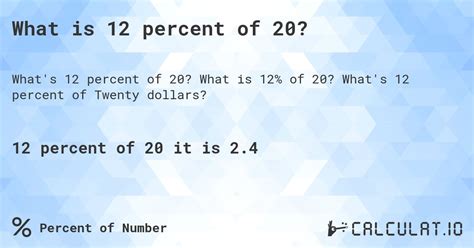What Is 12 Percent Of 20
Kalali
Mar 29, 2025 · 4 min read

Table of Contents
What is 12 Percent of 20? A Deep Dive into Percentage Calculations
Calculating percentages is a fundamental skill with applications across numerous fields, from everyday budgeting and shopping to complex financial analysis and scientific research. Understanding how to calculate percentages allows you to confidently interpret data, make informed decisions, and solve a wide range of problems. This article delves into the seemingly simple question, "What is 12 percent of 20?", exploring not just the answer but the underlying principles and various methods for solving percentage problems. We'll cover different approaches, highlight the importance of understanding the concept, and provide practical examples to solidify your understanding.
Understanding Percentages: The Basics
Before we tackle the specific problem, let's review the core concept of percentages. A percentage is simply a fraction expressed as a part of 100. The symbol "%" signifies "per cent" or "out of 100." Therefore, 12% can be interpreted as 12/100 or 0.12 in decimal form. This representation is crucial for performing calculations.
Key Terms and Concepts:
- Percentage: A fraction or ratio expressed as a number out of 100.
- Base: The total amount or the whole quantity that a percentage is calculated from (in our case, 20).
- Part: The portion of the base represented by the percentage (what we need to find).
- Rate: The percentage expressed as a decimal or fraction (in our case, 12%).
Calculating 12% of 20: Three Methods
There are several ways to calculate 12% of 20. Let's explore three common methods:
Method 1: Using the Formula
The most straightforward method involves using the basic percentage formula:
Part = (Rate/100) * Base
In our case:
- Rate = 12% = 0.12
- Base = 20
Substituting these values into the formula:
Part = (0.12/100) * 20 = 0.12 * 20 = 2.4
Therefore, 12% of 20 is 2.4.
Method 2: Converting to a Fraction
We can also express 12% as a fraction:
12% = 12/100 = 3/25
Then, multiply this fraction by the base:
(3/25) * 20 = (3 * 20) / 25 = 60/25 = 2.4
Again, we arrive at the answer: 12% of 20 is 2.4.
Method 3: Using Decimal Multiplication
This method leverages the decimal equivalent of the percentage:
12% = 0.12
Multiply this decimal by the base:
0.12 * 20 = 2.4
This confirms our answer: 12% of 20 is 2.4.
Practical Applications and Real-World Examples
Understanding percentage calculations is vital in numerous real-world scenarios. Here are a few examples:
1. Sales and Discounts:
Imagine a store offering a 12% discount on an item priced at $20. Using our calculation, the discount amount would be $2.40, resulting in a final price of $17.60 ($20 - $2.40).
2. Taxes and Fees:
Suppose a 12% sales tax is added to a $20 purchase. The tax amount would be $2.40, bringing the total cost to $22.40 ($20 + $2.40).
3. Interest Calculations:
If you invest $20 and earn 12% annual interest, you would gain $2.40 in interest after one year.
4. Data Analysis and Statistics:
Percentages are frequently used to represent portions of data in charts, graphs, and statistical reports. For instance, if 12% of a sample of 20 people prefer a particular product, this represents 2.4 individuals.
Beyond the Basics: Advanced Percentage Calculations
While calculating 12% of 20 is straightforward, let's explore more complex scenarios:
Finding the Percentage:
What if you knew the part (2.4) and the base (20) but needed to find the percentage? The formula would be rearranged:
Rate = (Part / Base) * 100
In this case:
Rate = (2.4 / 20) * 100 = 0.12 * 100 = 12%
Finding the Base:
Similarly, if you know the part (2.4) and the rate (12%), you can find the base:
Base = (Part / Rate) * 100
Base = (2.4 / 0.12) * 100 = 20 * 100 = 20
Tips and Tricks for Efficient Percentage Calculations
- Memorize common percentage equivalents: Knowing that 1/2 = 50%, 1/4 = 25%, and 1/10 = 10% can help you estimate and perform quick calculations.
- Use a calculator: For more complex problems, a calculator can save time and improve accuracy. Many calculators have a percentage function (%) that simplifies calculations.
- Practice regularly: The more you practice solving percentage problems, the more comfortable and proficient you will become.
- Break down complex problems: If you encounter a complicated percentage problem, break it down into smaller, manageable steps.
Conclusion
Calculating 12% of 20, while a seemingly simple problem, provides a solid foundation for understanding percentage calculations. Mastering this fundamental skill is essential for navigating various aspects of everyday life, academic pursuits, and professional endeavors. By understanding the core concepts, formulas, and different methods, you can confidently tackle more complex percentage calculations and effectively interpret data in a wide range of contexts. Remember to practice regularly and leverage available tools to enhance your proficiency in this crucial mathematical skill. The ability to work comfortably with percentages will undoubtedly enhance your numerical literacy and problem-solving capabilities.
Latest Posts
Latest Posts
-
250 Cm Is How Many Inches
Mar 31, 2025
-
Similarities Between Inner Planets And Outer Planets
Mar 31, 2025
-
34 Cm Is Equal To How Many Inches
Mar 31, 2025
-
Why Does A Plant Cell Need A Large Vacuole
Mar 31, 2025
-
80 Ounces Is How Many Liters
Mar 31, 2025
Related Post
Thank you for visiting our website which covers about What Is 12 Percent Of 20 . We hope the information provided has been useful to you. Feel free to contact us if you have any questions or need further assistance. See you next time and don't miss to bookmark.
